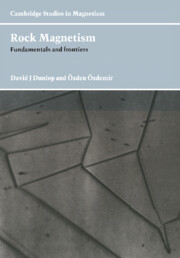Book contents
- Frontmatter
- Contents
- Preface
- Chapter 1 Magnetism in nature
- Chapter 2 Fundamentals of magnetism
- Chapter 3 Terrestrial magnetic minerals
- Chapter 4 Magnetostatic fields and energies
- Chapter 5 Elementary domain structures and hysteresis
- Chapter 6 Domain observations
- Chapter 7 Micromagnetic calculations
- Chapter 8 Single-domain thermoremanent magnetization
- Chapter 9 Multidomain thermoremanent magnetization
- Chapter 10 Viscous and thermoviscous magnetization
- Chapter 11 Isothermal magnetization and demagnetization
- Chapter 12 Pseudo-single-domain remanence
- Chapter 13 Crystallization remanent magnetization
- Chapter 14 Magnetism of igneous rocks and baked materials
- Chapter 15 Magnetism of sediments and sedimentary rocks
- Chapter 16 Magnetism of metamorphic rocks
- Chapter 17 Magnetism of extraterrestrial rocks
- References
- Index
Chapter 3 - Terrestrial magnetic minerals
Published online by Cambridge University Press: 06 July 2010
- Frontmatter
- Contents
- Preface
- Chapter 1 Magnetism in nature
- Chapter 2 Fundamentals of magnetism
- Chapter 3 Terrestrial magnetic minerals
- Chapter 4 Magnetostatic fields and energies
- Chapter 5 Elementary domain structures and hysteresis
- Chapter 6 Domain observations
- Chapter 7 Micromagnetic calculations
- Chapter 8 Single-domain thermoremanent magnetization
- Chapter 9 Multidomain thermoremanent magnetization
- Chapter 10 Viscous and thermoviscous magnetization
- Chapter 11 Isothermal magnetization and demagnetization
- Chapter 12 Pseudo-single-domain remanence
- Chapter 13 Crystallization remanent magnetization
- Chapter 14 Magnetism of igneous rocks and baked materials
- Chapter 15 Magnetism of sediments and sedimentary rocks
- Chapter 16 Magnetism of metamorphic rocks
- Chapter 17 Magnetism of extraterrestrial rocks
- References
- Index
Summary
Introduction
The most important terrestrial magnetic minerals are oxides of iron and titanium. Their compositions are conveniently represented on a Ti4+−Fe2+−Fe3+ ternary diagram (Fig. 3.1). The titanomagnetites (TM for short) are cubic minerals with inverse spinel structure (see §3.2). The mole per cent of Ti4+ is measured by the composition parameter x. TMO (i.e., titanomagnetite with x = 0) is magnetite and TM100 is ulvöspinel. The titanomaghemites are also spinel minerals. They are cation-deficient oxidation products of titanomagnetites. The degree of oxidation is measured by the oxidation parameter z. The titanohematites (often called hemoilmenites after the end-member minerals hematite and ilmenite) are also oxidized equivalents of the titanomagnetites, but their crystal structure is rhombohedral. Notice that minerals of the same composition but different structures occupy the same point on the ternary diagram. For example, maghemite (cubic or γFe2O3) and hematite (rhombohedral or αFe2O3) both plot in the lower right corner.
The titanomagnetites form a complete solid-solution series for all values of x at very high temperatures (see Lindsley (1976, 1991) for an equilibrium phase diagram) but intermediate compositions can only be preserved as single-phase minerals at ordinary temperatures if they cooled very rapidly. Submarine pillow lavas, for example, have been quenched by extrusion into seawater. Their primary magnetic oxides are single-phase TM60 grains. If the same basaltic magma cools more slowly in an oxygen-poor setting, the primary oxide will not be a single-phase mineral but an exsolution intergrowth of low-x (near-magnetite) and high-x (near ulvöspinel) cubic minerals.
- Type
- Chapter
- Information
- Rock MagnetismFundamentals and Frontiers, pp. 45 - 82Publisher: Cambridge University PressPrint publication year: 1997
- 1
- Cited by



